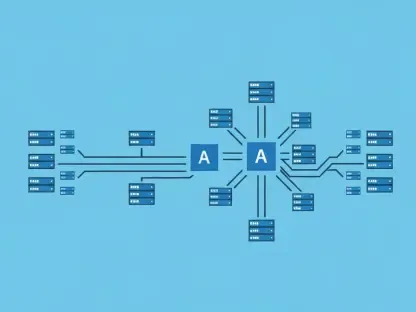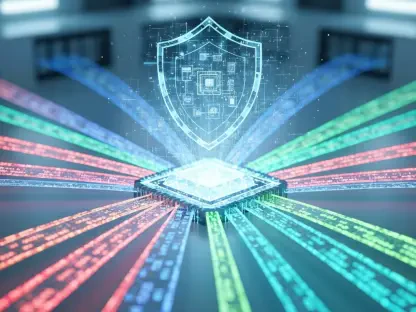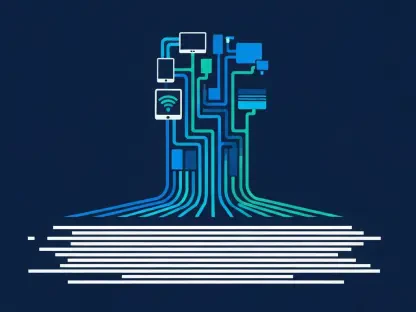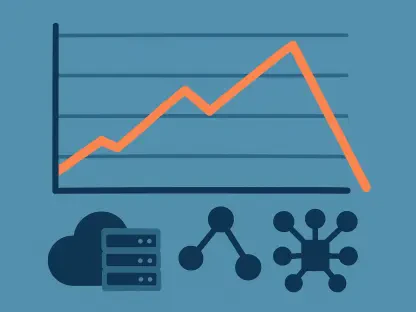In the ever-evolving landscape of cybersecurity, both artificial intelligence (AI) and human ingenuity play critical roles in defending against increasingly sophisticated cyber threats. Recent reports indicate a substantial rise in cyberattacks, making it imperative to explore how AI and human strategies can be leveraged to protect vulnerable sectors and strengthen overall cybersecurity.
Rising Tide of Cyber Threats
The Scary Statistics
A recent analysis from BT reveals a staggering increase in potential cyber threats, with the company detecting over 2,000 potential threats every second. This amounts to more than 200 million incidents daily, underscoring the growing menace in cyberspace. The rise in malicious internet protocol (IP) scanners on BT’s network is particularly alarming, with a 1,234% increase noted over the past year. These statistics not only illustrate the sheer volume of threats but also highlight the growing sophistication and determination of cybercriminals.
BT’s findings serve as a wake-up call for businesses and individuals alike. The sheer magnitude of these threats reveals a concerning trend where cybercriminals are continually evolving their tactics to exploit vulnerabilities. As the digital landscape becomes more complex, the methods used to infiltrate networks and systems are becoming increasingly advanced. Legitimate security scans are often overshadowed by a host of malicious activities, making it a constant challenge for cybersecurity professionals to discern and neutralize threats in real-time. This evolving threat landscape underscores the need for both proactive and reactive strategies to fortify defenses against such pervasive cyber threats.
Proactive vs. Reactive Measures
Addressing this surge requires both proactive and reactive cybersecurity measures. Proactive approaches include regular vulnerability assessments and employing advanced AI-driven threat detection tools. Organizations must invest in cutting-edge technologies that can predict and identify potential threats before they infiltrate systems. Continuous monitoring and risk assessments are crucial components of a proactive strategy, ensuring that vulnerabilities are identified and mitigated before they can be exploited.
On the other hand, reactive measures focus on rapid response and remediation to contain and mitigate the damage of an attack once it occurs. Incident response plans, disaster recovery strategies, and constant monitoring play pivotal roles in this aspect. Immediate action is necessary to minimize the impact of breaches, including isolating affected systems, restoring from backups, and conducting thorough forensic analyses to understand the breach’s scope and genesis. By combining both proactive and reactive measures, organizations can build a robust and resilient cybersecurity posture capable of withstanding the relentless efforts of cybercriminals.
Identified Vulnerable Sectors
High-Profile Targets
Defense, finance, and IT services are perennial targets for cybercriminals due to their integral role in national and economic security. These sectors possess valuable data, making them lucrative targets for malicious actors. The sophisticated nature of the attacks on these sectors necessitates constant vigilance and state-of-the-art security measures to protect these critical infrastructures. Cybercriminals often aim to disrupt operations, exfiltrate sensitive data, and undermine the integrity of these vital systems.
High-profile sectors like finance and defense cannot afford lapses in their cybersecurity measures. Financial institutions, for example, hold vast amounts of sensitive data that, if compromised, could result in significant financial losses and erosion of public trust. Similarly, breaches in the defense sector could have severe ramifications for national security. As these industries employ advanced technologies and interconnected systems, the attack surface for cybercriminals expands, making them even more attractive targets. Therefore, these sectors must continually invest in up-to-date security solutions and practices, leveraging both AI and human expertise to defend against sophisticated cyber threats.
Emerging Vulnerable Sectors
Other sectors, particularly healthcare and education, are increasingly under threat. These industries often lack the financial resources to implement robust cybersecurity measures. Consequently, they become soft targets for cybercriminals, who exploit their limited defenses and the highly sensitive nature of the data they handle. The dual impact of data theft and system incapacitation can have devastating consequences on public services, making these sectors increasingly attractive to attackers.
The sensitive nature of data in the healthcare and education sectors makes them enticing targets for ransomware attacks. Healthcare institutions, for example, manage vast amounts of personal and medical data, making them lucrative targets for cybercriminals looking to hold this critical information hostage for ransom. Similarly, educational institutions, which manage extensive personal and academic records, have found themselves targeted more frequently. The financial constraints in these sectors hamper their ability to implement comprehensive cybersecurity measures, leaving them vulnerable. Addressing these vulnerabilities requires collaborative efforts, increased funding, and tailored security solutions to protect these essential services adequately.
The Role of AI: Double-Edged Sword
AI as an Enabler of Sophisticated Attacks
AI technology is a double-edged sword in the world of cybersecurity. On one hand, it enables cybercriminals to conduct more sophisticated scans and attacks, increasing the volume and complexity of threats. AI-driven malware and automated phishing schemes are just a few examples of how technology can be harnessed for malicious purposes. These innovations allow cybercriminals to launch attacks at an unprecedented scale and speed, often outpacing traditional defensive measures.
The rise of AI-driven cyberattacks necessitates a shift in defensive strategies. Traditional cybersecurity measures may no longer suffice against these advanced threats, which can quickly adapt and evolve to bypass defenses. Cybercriminals are leveraging AI to automate attacks, making them more precise and harder to detect. This trend highlights the need for constant innovation in defense mechanisms, where human intuition and AI capabilities must work in tandem to counteract these sophisticated threats effectively. As AI continues to evolve, so too must the strategies and technologies employed to defend against its misuse.
AI as a Defender
Conversely, AI also offers robust defensive capabilities. AI’s ability to learn and adapt allows for more sophisticated threat detection and prevention. For instance, predictive analytics can anticipate and neutralize threats before they cause harm. AI-driven security solutions can analyze vast amounts of data in real-time, identifying patterns and anomalies indicative of potential threats. These solutions can act swiftly, often faster than human response times, to neutralize threats before they escalate.
However, cybersecurity professionals must remain vigilant, as the very tools used for defense can also be used for offense. The dual nature of AI means that continuous monitoring, updating, and improvement of AI-driven defenses are imperative to stay ahead of malicious actors. Organizations should invest in AI-driven security technologies that augment human expertise, creating a synergy that leverages the strengths of both. By incorporating AI into defensive strategies, organizations can better protect themselves against the increasing sophistication and scale of cyber threats in today’s digital landscape.
BT’s Countermeasures and Strategic Insights
Adaptive Security Measures
Tris Morgan, BT’s Managing Director of Security, stresses the importance of adaptive security measures. Drawing an analogy to burglars looking for vulnerabilities, Morgan underscores the necessity of evolving security protocols. This involves continuously updating threat intelligence and adapting defensive strategies accordingly. Cybercriminals are constantly changing their tactics, so static defenses are inadequate in the face of dynamic threats. Adaptive security measures involve real-time monitoring, threat analysis, and updating security measures to address new challenges.
Adaptive security measures are essential for maintaining robust cybersecurity defenses. By continually analyzing emerging threats and adapting strategies, organizations can stay one step ahead of cybercriminals. This approach includes implementing advanced threat detection systems that use AI to identify and respond to potential risks in real-time. Additionally, continuous education and training for security personnel help ensure they are equipped to deal with evolving threats. The combination of advanced technology and human expertise allows for a dynamic and resilient defense mechanism, capable of withstanding the unpredictable nature of cyber threats.
AI Integration in Defense
BT advocates for the use of AI as a critical layer of defense. By integrating AI into their cybersecurity framework, BT aims to mitigate threats more effectively. The use of AI can automate the detection and response processes, making it possible to handle the sheer volume of threats while freeing up human resources to focus on strategic initiatives. AI-driven solutions can quickly identify anomalies, assess potential risks, and initiate protective measures, all within fractions of a second.
The integration of AI in cybersecurity serves as a force multiplier, enhancing the efficiency and effectiveness of defense mechanisms. AI can process vast amounts of data at speeds unattainable by human analysts, identifying subtle patterns and indicators of potential threats. This capability is crucial in today’s fast-paced digital environment, where cyber threats can emerge and escalate rapidly. Moreover, AI integration allows cybersecurity teams to focus on higher-level strategic planning and decision-making, as routine tasks and initial threat assessments are managed by AI systems. This symbiotic relationship between AI and human expertise is key to developing a comprehensive and resilient cybersecurity framework.
Best Practices and Tools for Cybersecurity
Robust Malware Removal Software
One key defensive measure is the deployment of robust malware removal software. These tools are essential for identifying and eliminating malware before it can cause significant damage. Regular updates and real-time scanning capabilities are crucial features of effective malware removal solutions. By keeping malware removal software up-to-date, organizations can ensure they are protected against the latest threats, minimizing the risk of infections and breaches.
Robust malware removal software is a fundamental component of cybersecurity defense. These tools provide a first line of defense against malicious software, which can infiltrate systems and compromise data integrity. Regular updates ensure that the software can recognize and remove newly emerging threats, while real-time scanning capabilities allow for continuous monitoring and immediate action. Organizations should prioritize investing in high-quality malware removal solutions, as these tools play a crucial role in maintaining the security and integrity of their digital environments.
Endpoint Security Tools
Protecting endpoints, such as computers and mobile devices, is another critical aspect of cybersecurity. Effective endpoint security tools help protect these devices from threats, ensuring that they do not become entry points for cybercriminals. These tools should include features like encryption, device management, and intrusion detection. By securing endpoints, organizations can prevent unauthorized access and minimize the risk of data breaches.
Endpoint security is essential in safeguarding the various access points within an organization’s network. As more employees use mobile devices and remote work becomes more prevalent, securing these endpoints becomes increasingly critical. Comprehensive endpoint security solutions provide multiple layers of protection, including encryption to safeguard data, device management to control access, and intrusion detection to identify and respond to potential threats. By implementing robust endpoint security measures, organizations can enhance their overall cybersecurity posture and protect sensitive data from unauthorized access and exploitation.
Adherence to Best Practices
Beyond tools, the adherence to best cybersecurity practices cannot be overstated. This includes regular training for employees on recognizing phishing attacks, implementing strong password policies, and conducting regular security audits. These practices help create a culture of security awareness, thereby reducing the likelihood of successful attacks. By fostering a security-conscious environment, organizations can empower their employees to act as the first line of defense against cyber threats.
Adherence to best practices is essential in building a resilient cybersecurity framework. Employee training programs should focus on educating staff about the latest threats and how to recognize potential phishing attempts. Implementing strong password policies, including the use of multi-factor authentication, adds an extra layer of protection. Regular security audits help identify vulnerabilities and ensure compliance with security protocols. By prioritizing these best practices, organizations can mitigate risks and enhance their overall cybersecurity defenses, creating a safer digital environment for their operations.
Trends and Future Implications
Increasing Sophistication of Attacks
The trend towards more sophisticated and frequent cyberattacks is likely to continue. With the advent of AI-driven threats, the landscape becomes even more complex. Cybersecurity experts emphasize the need for continuous innovation and adaptive strategies to keep pace with evolving threats. Organizations must remain vigilant, continually updating their defense mechanisms to address new challenges and enhance their resilience against future attacks.
The increasing sophistication of cyberattacks underscores the importance of proactive and innovative defensive strategies. As AI-driven threats become more prevalent, traditional cybersecurity measures may no longer suffice. Organizations must invest in advanced technologies and develop adaptive strategies that can respond to emerging threats in real-time. Collaboration between public and private sectors is also crucial in addressing the growing complexity of cyber threats. By staying ahead of the curve and adopting a proactive approach to cybersecurity, organizations can better protect themselves against the evolving threat landscape.
Comprehensive Defensive Strategies
In today’s rapidly changing world of cybersecurity, the collaboration between artificial intelligence (AI) and human expertise is vital for combating the growing number of sophisticated cyber threats. With a marked increase in cyberattacks reported recently, the urgency to understand and enhance the synergy between AI tools and human strategies becomes clear. AI can efficiently analyze vast amounts of data to detect anomalies and potential threats more swiftly than humans alone. However, human intuition and critical thinking are indispensable for interpreting these insights, making judgments in ambiguous situations, and responding to threats in real-time.
A balanced fusion of AI and human ingenuity helps in identifying vulnerabilities that might otherwise go unnoticed and enables quicker, more effective responses to breaches. Various sectors, from finance to healthcare, stand to benefit tremendously from this partnership, as both AI and human cybersecurity professionals work together to fortify defenses. Awareness and continuous improvement of this integrative approach are crucial for staying ahead of cybercriminals and ensuring robust security measures in an increasingly digital era.









